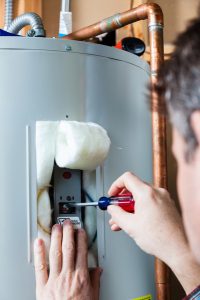Sediment: Your Water Heater’s Worst Enemy
 Tank water heaters are burly systems that can handle plenty of stress over their lifespan. However, there’s one thing that can significantly reduce their lifespan:
Tank water heaters are burly systems that can handle plenty of stress over their lifespan. However, there’s one thing that can significantly reduce their lifespan:
Water heater sediment.
Now, water heater sediment is largely unavoidable for the most part, and it can easily be removed from the water heater before it causes damage. It can also be reduced with a water softener.
We’ll go into more detail below about water heater sediment, how it forms, and what can be done about it.
What is Sediment, and How Does it Form?
First, we have to talk about hard water. You’ve likely heard the term before and are familiar with some of the complaints surrounding it: it can leave soap scum on your glass and utensils, dry out your skin, turn your clothes dull and scratchy, and more.
But more specifically, hard water is water with a high concentration of minerals that don’t dissolve. While water will flow through several kinds of minerals before making it to the municipal treatment, the two minerals that will stubbornly refuse to dissolve are magnesium and calcium.
Once that water is exposed to the high temperature of the water heater, it turns those minerals into scale, which ends up as sediment at the bottom of your water heater’s tank.
Water heaters in New Mexico are especially susceptible since it’s one of the states in the nation with a high concentration of hard water.
Why Does it Need to Be Removed?
A little bit of water heater sediment isn’t going to cause substantial damage to the tank. However, problems can develop when the sediment begins building up.
Risk of Leaks: Pockets of high temperatures can form beneath the sediment. They can even become hot enough to burn a hole through the tank, thus rendering your water heater useless.
Reduced Efficiency: As the sediment builds, it forms a layer between the heating elements and the water itself. This forms an insulator that will make it take longer to heat the water, and that can lead to an increase in heating costs.
Kettling Noises: Sediment can create popping or cracking noises. This is a result of air bubbles popping from underneath the sediment. Although not harmful on its own, you should take it as a signal to have the sediment taken care of.
Just Perform a Simple Flush
We’ve established that sediment isn’t a good thing, but what are you supposed to do about it? Luckily, there’s an easy solution: having the tank flushed.
Flushing the tank isn’t difficult, but the average homeowner isn’t going to be able to do much beyond that. That’s why we recommend having a water heater flush done at the same time as a maintenance check. A professional will be able to do it for you while inspecting the tank for damages or signs of corrosion.
Consider Water Softening
The second thing you can do is reduce the amount of sediment buildup by installing a water softener. These systems use sodium in a chemical process that removes a majority of the hard water minerals.
Before having a softener installed, you should get water testing services. This will help your plumber to install the proper softener, including whether it should be whole-house or point-of-use.
To learn more about water softeners and caring for your water heater, contact Santa Fe Express Plumbing & Drain today.

